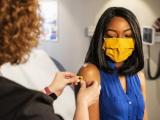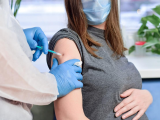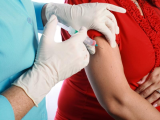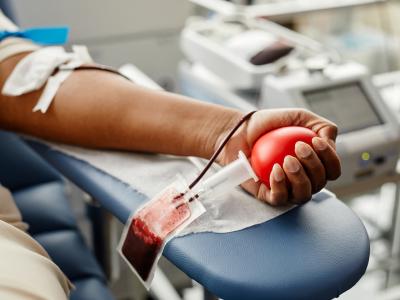Apr 29, 2010 (CIDRAP News) – Seasonal influenza vaccination coverage for the 2009-10 season surged in children and rose moderately in healthy young adults, perhaps because of increased awareness triggered by the H1N1 flu pandemic, the Centers for Disease Control and Prevention (CDC) reported today.
Using two surveys, the CDC estimated that 40% of children aged 6 months through 17 years received seasonal flu shots, a relative 67% increase from the 24% level in 2008-09. For younger adults (18 to 49) without high-risk conditions, coverage was estimated at 27.6%, up about 30% from the 20.8% coverage the year before.
"These higher coverage levels for 2009-10 might reflect increased awareness of the seriousness of influenza associated with the H1N1 pandemic," the CDC said in an article in the Apr 30 Morbidity and Mortality Weekly Report. But the article also warns that, because of survey limitations, the true coverage numbers are probably lower.
As the report notes, the 2009-10 seasonal vaccination drive was unusual in that it overlapped with the pandemic H1N1 vaccination effort, with the seasonal campaign starting in August and the pandemic effort in October. The two immunization drives targeted some, but not all, of the same groups. In addition, 2009-10 marked the first full year of expansion of the seasonal vaccination target groups to include all school-aged children.
For demographic groups other than children and young healthy adults, the 2009-10 seasonal coverage estimates were about the same as in 2008-09, the CDC said. Uptake in younger adults with high-risk conditions was estimated at 36.2%. Coverage was estimated at 45.0% for those between 50 and 64 years and at 68.0% for those 65 and up.
Coverage for the population as a whole was estimated at 39.7%. That compares with an overall estimate of 32.6% for the 2008-09 season, which was based on survey data from 19 states, as reported in MMWR in October 2009.
The coverage figures in today's report are considerably higher than those the CDC issued a few weeks ago for H1N1 vaccine uptake. Using the same two surveys, the CDC estimated overall pandemic vaccine coverage at 24% to 27%, compared with the 39.7% overall uptake of the seasonal vaccine.
The CDC estimate of H1N1 vaccine coverage in children was 36.8%, compared with 40.0% for the seasonal vaccine. Overall H1N1 coverage in adults was estimated at 20.1%, versus 39.6% for the seasonal vaccine.
Higher uptake of the seasonal immunization compared with the H1N1 vaccine may reflect supply and timing factors and the fact that the seasonal vaccination effort targeted a larger share of the population. The H1N1 vaccine was in limited supply when the fall H1N1 wave peaked in late October and early November, and cases had waned significantly by the time the vaccine became more plentiful in December and January. The seasonal vaccine became available in August, and availability was generally better than for the pandemic vaccine.
Seasonal vaccine uptake varied widely from state to state. For children, the figures ranged from 23.6% for Nevada to 67.2% for Hawaii, with a median of 41.2%. Adult coverage by state ranged from 32.4% in Nevada to 52.5% in Minnesota, with a median of 40.6%.
The CDC found ethnic disparities in vaccine uptake similar to those seen in past years. All-ages coverage was highest in non-Hispanic whites at 42.5%, followed by Asians, 41.7%; Hispanics, 33.6%; and non-Hispanic blacks, 32.2%.
The data were collected between October 2009 and January 2010 through the CDC's Behavioral Risk Factor Surveillance System surveys and the National 2009 H1N1 Flu Survey (NHFS). A total of 262,417 people responded to the telephone surveys, in which respondents were asked if they or their children had received a seasonal flu shot or an H1N1 flu shot in the preceding year and, if so, when. Estimates from the two surveys were combined.
The survey data indicated that 29.1 million children and 89.7 million adults received the vaccine, for a total of 118.8 million people. But the CDC says this is an overestimate, because only 114 million to 115 million doses of vaccine were distributed. The error is attributed to nonresponse bias and recall bias in the surveys.
The survey data have other limitations, including low response rates and possible confusion of H1N1 vaccine with seasonal vaccine, the report says. "Given all of these factors combined, the net bias (estimated coverage minus actual coverage) range likely is 10%-15%," it states.
On the other hand, the demand for seasonal vaccine stayed strong even after shortages emerged in some places, which suggests that a larger share of the doses were used than in past years, the report adds.
CDC. Interim results: state-specific seasonal influenza vaccination coverage—United States, August 2009–January 2010. MMWR 2010 Apr 30;59(16):477-84 [Full text]
MMWR article
See also:
October 2009 MMWR report on seasonal flu vaccine coverage in 2008-09
http://www.cdc.gov/mmwr/preview/mmwrhtml/mm5839a1.htm
Apr 1 CIDRAP News story "CDC estimates 24% of Americans received H1N1 vaccine"

















